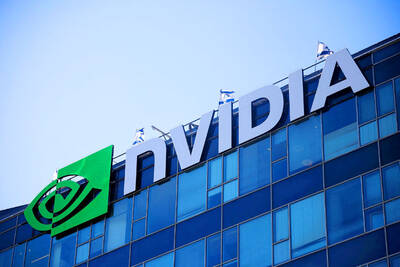In the air, in your car, on your back — new technology at the upcoming Consumer Electronics Show (CES) is showcasing the growing number of ways to live the “connected life.”
The so-called Internet of Things is leading to a wider range of wearable tech, from sports shirts to smartwatches to sleep monitors to connected refrigerators.
The vast 2015 International CES, one of the world’s biggest electronics fairs to be held in Las Vegas from Tuesday to Friday next week, shows how technology is permeating virtually all sectors of life — from entertainment to automobiles to kitchen appliances, in sectors including health, fashion and sports.
“The Internet of Things is the hottest topic in tech right now,” said Karen Chupka of the Consumer Electronics Association, which organizes the annual event. “It’s all about the opportunity to connect everyday items like cars, home security systems and kitchen appliances to networked devices like PCs and smartphones for greater control and management of our everyday lives.”
Also on view will be the newest and biggest TV displays featuring “ultra-high definition” that is catching on with consumers.
So-called 4K TV sets are coming down in price and becoming mainstream, and some reports suggest the show might feature newer, even more realistic “8K” displays.
Endpoint Technologies Associates analyst Roger Kay said that 4K “is a really obvious play for the industry and consumers” because it can mean big-ticket purchases, and deliver a better image.
While 4K TV has been around a few years, the market might be ready now, says Bob O’Donnell at the research firm Technalysis, with prices for TV sets falling below US$1,000.
The 4K format “is more 3D-like than 3D,” O’Donnell said. “The quality is so high it makes you feel like you’re there.”
Curved and bendable screens should be on display, and perhaps some folding ones as well.
In the air, CES will for the first time have a dedicated space for drones to accommodate the growing interest in unmanned flying devices. This comes with interest in drones for everything from law enforcement to crop management to search-and-rescue missions.
A separate robotics zone will be 25 percent bigger than it was last year, with at least 18 exhibitors. Some robots are connected to cloud services on the Internet, or controllable by mobile device and capable of seeing, hearing, feeling and reacting to the environment.
A wider range of wearable technology will also be on display at the show, in a key segment among the 35,000 exhibitors.
While smartwatches and fitness bands have been on the market, “I expect to see more smart garments, including smart shirts and smart bras,” Gartner analyst Angela McIntyre said. “We’ll be seeing more traction with smart garments next year.”
These garments are likely to replace more restrictive heart-monitoring straps and bands which are “effective, but uncomfortable,” McIntyre said.
More important than the wearable items themselves will be the platform behind them.
Users will be looking for ways to use the data in a productive way, IDC analyst Ramon Llamas said.
“A wearable device can tell you that you have walked 10,000 steps, but we need more than that,” Llamas said. “People are looking for devices which tell us when we need to go to sleep earlier, skip dessert or get up and take a walk around the office.”
A major battle is taking place to be the software platform of choice for wearables, with Google Inc, Apple Inc, Microsoft Corp and others seeking domination.
“There is no dominant company yet,” McIntyre said. “What we will be seeing is a shift from the device and its app, to having an integrated account where people can get insights about their fitness and health not just from one device, but from several wearables.”
Smart glasses and watches will also be out in force, even before the commercial launch of items such as Google Glass and the Apple Watch. Rivals will be looking to get into these markets, although consumers might want to wait for anticipated products, such as the Apple Watch, due sometime this year.
O’Donnell said the successful smartwatches will pay close attention to style.
“The watch is a very personal device; it’s much more personal than a phone you put in your pocket,” he said. “That’s going to lead to experimentation.”
While smart glasses will be on display, “there are a lot of privacy and creepiness issues” to be overcome, O’Donnell said.
The “smart home” segment will be significant, with connected devices such as light bulbs, ovens, refrigerators, window systems and garage doors, but software is equally important in this market as well.
O’Donnell said consumers want an integrated system to avoid having a multitude of different apps, but that developers want an open system that is easy to access.
“On the connected home side, it’s all about getting these things to talk to each other,” he said. “So I can have a control panel that can talk to a smart lightbulb or thermostat.”
In a sign of the importance of automotive electronics, CES will have 10 car manufacturers showing their entertainment, safety and other technical advances — from self-parking cars to systems that use Big Data to navigate or diagnose problems.
“We are seeing ways to collect data from the car, send you firmware for the vehicle, real-time traffic, Wi-Fi hotspots for the passengers,” O’Donnell said. “We could see better diagnostics, so you can tell if your spark plug is going to die and needs to be replaced.”

Taiwan Semiconductor Manufacturing Co (TSMC, 台積電) last week recorded an increase in the number of shareholders to the highest in almost eight months, despite its share price falling 3.38 percent from the previous week, Taiwan Stock Exchange data released on Saturday showed. As of Friday, TSMC had 1.88 million shareholders, the most since the week of April 25 and an increase of 31,870 from the previous week, the data showed. The number of shareholders jumped despite a drop of NT$50 (US$1.59), or 3.38 percent, in TSMC’s share price from a week earlier to NT$1,430, as investors took profits from their earlier gains

In a high-security Shenzhen laboratory, Chinese scientists have built what Washington has spent years trying to prevent: a prototype of a machine capable of producing the cutting-edge semiconductor chips that power artificial intelligence (AI), smartphones and weapons central to Western military dominance, Reuters has learned. Completed early this year and undergoing testing, the prototype fills nearly an entire factory floor. It was built by a team of former engineers from Dutch semiconductor giant ASML who reverse-engineered the company’s extreme ultraviolet lithography (EUV) machines, according to two people with knowledge of the project. EUV machines sit at the heart of a technological Cold

AI TALENT: No financial details were released about the deal, in which top Groq executives, including its CEO, would join Nvidia to help advance the technology Nvidia Corp has agreed to a licensing deal with artificial intelligence (AI) start-up Groq, furthering its investments in companies connected to the AI boom and gaining the right to add a new type of technology to its products. The world’s largest publicly traded company has paid for the right to use Groq’s technology and is to integrate its chip design into future products. Some of the start-up’s executives are leaving to join Nvidia to help with that effort, the companies said. Groq would continue as an independent company with a new chief executive, it said on Wednesday in a post on its Web

CHINA RIVAL: The chips are positioned to compete with Nvidia’s Hopper and Blackwell products and would enable clusters connecting more than 100,000 chips Moore Threads Technology Co (摩爾線程) introduced a new generation of chips aimed at reducing artificial intelligence (AI) developers’ dependence on Nvidia Corp’s hardware, just weeks after pulling off one of the most successful Chinese initial public offerings (IPOs) in years. “These products will significantly enhance world-class computing speed and capabilities that all developers aspire to,” Moore Threads CEO Zhang Jianzhong (張建中), a former Nvidia executive, said on Saturday at a company event in Beijing. “We hope they can meet the needs of more developers in China so that you no longer need to wait for advanced foreign products.” Chinese chipmakers are in